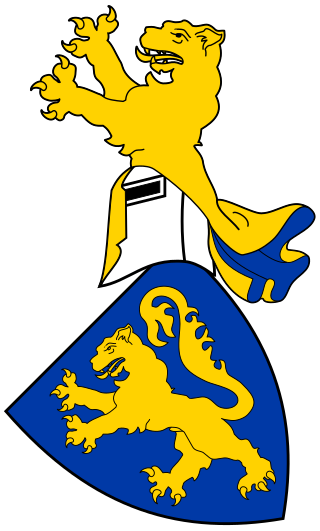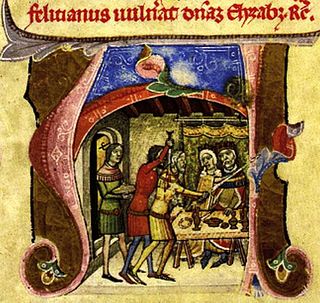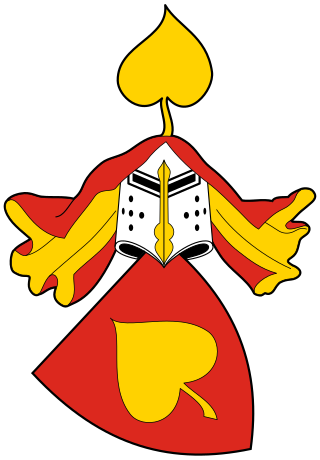
Richeza of Poland was Queen of Hungary by marriage to Béla I.
Maria Komnene was Queen of Hungary and Croatia from 1163 until 1165. Maria's father was Isaac Komnenos.
Lampert was a member of the Árpád dynasty; Duke of one-third of the Kingdom of Hungary.

Csák was the name of a gens in the Kingdom of Hungary.
The county of the Bakony was a royal land in the Kingdom of Hungary in the Bakony forest formed in the 12th century. Originally it had no castles or significant population, neither were there bigger donations. In the 15th century it merged into Veszprém county.

Béla of Macsó was a member of the Olgovichi clan. He was Duke of Macsó (1262–1272) and of Bosnia (1266/1271–1272); and thus he governed the southern provinces of the Kingdom of Hungary.
Michael of Bosnia, Duke of Bosnia from 1262 to 1266, was a member of the Olgovichi clan.
Jelek, Hülek or Üllő was the third son of Grand Prince Árpád. The name might be related to the Khazar title Ilik/Ilek.

Záh was the name of a gens in the Kingdom of Hungary. The clan was one of the 108 gentes during the Hungarian conquest of the Carpathian Basin and located in Nógrád County along with the Kacsics, Kartal, Kökényesradnót and Tomaj clans.
Kaplon was a Hungarian tribal chieftain, the second son of Kond, who was one of the seven chieftains of the Magyars according to Anonymus, author of the Gesta Hungarorum. It is possible that Kurszán, who was killed in 904, was his elder brother.

Rátót was the name of a gens in the Kingdom of Hungary. According to Simon of Kéza and other chroniclers, the ancestors of the clan were Italians from Caserta, Naples, by name Rathold and Oliver, who settled down in Hungary around 1097 during the reign of Coloman, King of Hungary. They came to Hungary alongside Felicia of Sicily.
Smaragd (Smaragdus) or Zsámbéki was the name of a gens in the Kingdom of Hungary. The ancestor of the clan was a French knight calling himself at that time "Ainordi (Aynard) de Champagne", who settled down in Hungary around 1186 during the reign of Béla III of Hungary and received use of the estate of Zsámbék under a royal grant. His descendants, the gens Smaragd built the Zsámbék Premontre monastery church.
Bogátradvány was the name of a gens in the Kingdom of Hungary. The powerful Rákóczi family ascended from this gens.

The Zselicszentjakab Abbey was a Benedictine monastery established at Zselicszentjakab in Somogy County in the Kingdom of Hungary in 1061. Its founder was the Palatine Otto of the Győr clan. The monastery was dedicated to the Apostle Saint James the Great. The deed of the foundation of the monastery – drafted by George, Bishop of Veszprém – is the first extant charter issued by a nobleman in the Kingdom of Hungary.
Otto (Atha) from the kindred Győr was a Hungarian noble in the second half of the 11h century, who served as palatine in 1066, during the reign of Solomon, King of Hungary. He was the ancestor of the gens Győr, which flourished until the 17th century.

Apor was a Hungarian tribal chieftain, who, according to the Illuminated Chronicle, led a campaign against the Byzantine Empire in 959, where the legend of Botond takes place. He was the ancestor of the gens Apor.
The castle folk formed a class of freemen, in the medieval Kingdom of Hungary, who were obliged to provide well-specified services to a royal castle and its ispán, or count. They were peasants living in villages formed in the lands pertaining to the royal castle and tilled their estates collectively.

The Kőszegi was a noble family in the Kingdom of Hungary and the Kingdom of Croatia in the 13th and 14th centuries. The ancestor of the family, Henry the Great, descended from the gens ("clan") Héder. Henry's paternal great-grandfather was the clan's co-founder Wolfer.
Bogát was a 10th century Hungarian General, according to Liudprand, Bogát was one of the leaders of the 921–922 Italian Campaign under the name Busak. According to László Makkai, he then became the first Gyula of Transylvania. Gyula Kristó explains the origin of his name from the Slavic word ("rich").
Bár-Kalán was an aristocratic kindred in the Kingdom of Hungary. The Gesta Hungarorum states that Ond – one of the seven chieftains of the Magyars during their conquest of the Carpathian Basin – was the clan's forefather. The first documented estates of the clan were located in Baranya and Esztergom Counties.









